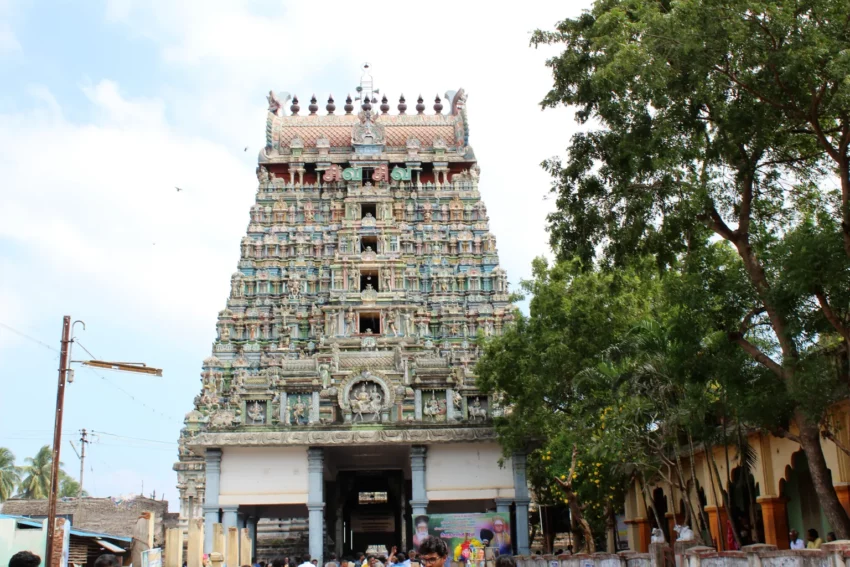Historical Overview of Amritaghateswarar-Abirami Temple
The Amritaghateswarar-Abirami Temple, situated in Thirukkadaiyur, Tamil Nadu, India, is a prominent Hindu temple dedicated to the deity Shiva in his manifestation as Amritaghateswarar and his consort, the goddess Parvati in the form of Abirami. This ancient temple carries significant historical and religious value. It is notably associated with the legend of Shiva saving his devotee Markandeya from death, highlighting its importance in Shaivism, the sect of Hinduism dedicated to Lord Shiva.
Get your dose of History via Email
Architectural and Cultural Significance
Reflective of Dravidian architecture, the Amritaghateswarar-Abirami Temple boasts of impressive structures such as its five-tiered Rajagopuram (the temple’s main gateway), vast courtyards, and multiple shrines. The temple is part of the UNESCO World Heritage Site “Great Living Chola Temples,” underlining its architectural marvel and historical importance. Because of its association with life and death, the temple hosts the 60th and 80th birthday celebrations, known as Sashtiabdhapoorthi and Sadhabishegam, respectively.
The Historical Origin and the Temple Time Period
According to the historical accounts, the original structure of the temple dates back to 11th century AD during the reign of Raja Raja Chola I. However, inscriptions in the temple indicate contributions by both the Great Cholas and the subsequent rulers of the Vijayanagar Empire, which suggest renewal and additions over time, likely during the 16th century AD. This demonstrates the temple’s enduring importance and the sustained patronage it received throughout different eras in South Indian history.
The Mythological Aspect
The mythology intertwined with the Amritaghateswarar-Abirami Temple is a crucial aspect of its historical fabric. The narrative of a young boy, Markandeya, destined to die at the age of sixteen but saved from the clutches of death by Shiva, is a foundational myth that emphasizes the temple’s significance as a site of life’s continuity. Moreover, it is believed that the marriage of Shiva and Parvati was witnessed by all the celestial deities at this temple, adding layers to its religious importance.
Deity Worship and Temple Rituals
In this temple, Shiva is worshipped as the main deity along with Parvati who is celebrated in her form as Abirami. There is a special niche in the temple known as the Abirami Amman shrine where the goddess is venerated. Furthermore, pilgrimage and worship at this temple are amplified during the Tamil month of Adi (July–August) and Thai (January–February) when large festivals honouring the deities take place. These festivals facilitate a connection between the divine mythological past and the contemporary practices of devotees.
Archaeological Perspective and Epigraphy
From an archaeological standpoint, the Amritaghateswarar-Abirami Temple offers a rich source of historical data. The plethora of inscriptions present in the temple are pivotal in understanding the socio-political and religious history of the region. The inscriptional evidence suggests that the temple functioned not just as a religious center but also played a role in the administration and economy of the period. These inscriptions detail donations made to the temple, its lands, and the rituals followed, allowing historians to piece together the multifaceted history of the temple’s operations and significance.
Modern-Day Relevance and Conservation
In contemporary times, the Amritaghateswarar-Abirami Temple remains an active site of Hindu worship and an important cultural relic. Recognized by the Archaeological Survey of India (ASI) as a monument of national importance, the temple continues to be preserved as an invaluable specimen of Tamil Nadu’s Chola-era craftsmanship and religious traditions. Its inclusion in the Great Living Chola Temples UNESCO World Heritage Site further ensures its place in both national and global heritage, preserving it for generations to come.
Conclusion
The Amritaghateswarar-Abirami Temple stands as a testament to the splendor of Chola architecture and the depth of religious practice and belief in the region. Its rich tapestry of history, mythology, and art renders it not just an architectural treasure but also a landmark of human faith throughout the centuries. The continuing traditions and careful preservation of the site maintain its relevance and testament to the timeless reverence paid to the deities enshrined within. Thus, the temple not only embodies the spiritual dedication of its followers but also offers an invaluable window into the historical narrative of South India’s past.
Sources: Wikipedia

